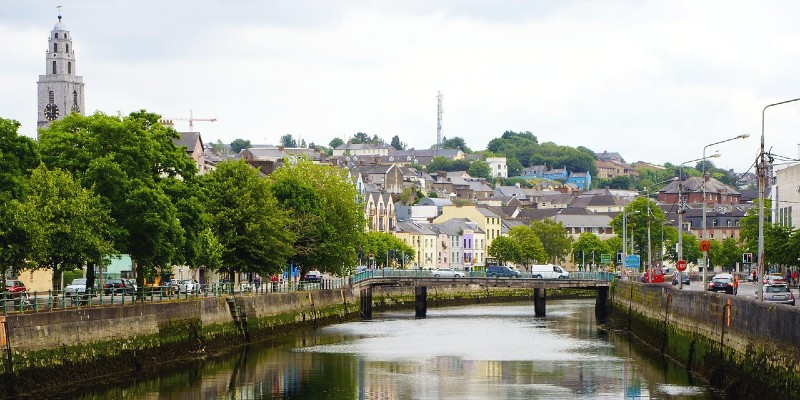Cork – Ireland’s second largest city after Dublin, but also perhaps its most remote way down in the southwest of the country on the Atlantic coast. The very western edge of Europe, the jumping-off point to America for so many. Ciara Doorley, publishing director of Hachette Ireland, recently told the Irish Examiner that Cork’s size makes it the perfect setting for a crime novel. “Cork is a really interesting setting for crime because while it’s a capital city, it also has that sense of intimacy and a really unique identity that bigger cities don’t have.”
Windswept and coastal, Cork was largely a town of farmers and fisherman until the 1960’s, when it was discovered by the so-called “blow–ins”. Blow-ins come from all over, people who found a magic in the landscape and coastline around Cork, or, as one writer described them, ‘People who drove until the road ran out, artists and urban runaways – finding a haven for those ready to turn their backs on their old lives and start again.’
And arguably it’s the blow-ins that have unfortunately put Cork on the true crime map. The 1996 murder of French television producer Sophie Toscan du Plantier at her holiday home outside Cork has sparked a raft of true crime books, podcasts, TV documentaries, and speculation. Sophie’s murder has become an industry in the last decades. I’ll just mention a few books on the case.
Ralph Riegel’s A Dream of Death: How Sophie Toscan du Plantier’s Dream became a Nightmare and a West Cork Village Became the Centre of Ireland’s Most Notorious Unsolved Murder (2020) is seen by many as the definitive book on the murder as Riegel has followed the case since the start. But it’s far from the only one. Elio Maloco’s Killing Sophie (2021) focuses on the long-time prime suspect – a “blow in”, Ian Bailey, an English journalist who had reported on Sophie’s death. Bailey was convicted in his absence by the Paris criminal court for the murder and sentenced to 25 years in prison. Maloco’s book is essentially the case against Bailey. Michael Sheridan’s The Murder of Sophie (Part One) (2019) also examines the case against Bailey. The Murder of Sophie (Part Two) with more information followed in 2020. There are now at least a dozen other in depth studies into the Sophie Toscan du Plantier murder as well as major podcasts and TV docs. As of today the Paris court’s conviction remains but Ireland’s High Court in Dublin has ruled that Bailey could not be extradited to France. So stalemate for now.
If nothing else all the books, documentaries, and podcasts on Sophie Toscan du Plantier have certainly put a lot of pressure on the Irish police, An Garda Síochána, to try and resolve the murder enquiry. In June 2022 it was reported that the Garda Serious Crime Review Team would conduct “a full review” of the murder case.
From true crime to crime fiction. Cora Harrison’s Reverend Mother whodunnit series starts with A Shameful Murder (2019). Set in 1923 in the midst of the Irish Civil War in Cork, Reverend Mother Aquinas discovers a body at the gate of her convent chapel in Cork, washed up after a flood ‘like a mermaid in gleaming silver satin’. Police Sergeant Patrick Cashman is assigned the case. The woman is not from the city’s slums but from its gentry and had a and a midnight ticket for the Liverpool ferry in her purse. The Reverend Mother, together with Sergeant Cashman and Dr Sher, an enlightened local physician, investigate.
The Reverend Mother is now a ten book series ranging through the city’s markets, a priest found dead in the confessional, Cork’s merchant class social circles, dead nuns, bodies in Cork harbour and the wealthy Bachelor’s Quay area, some local political skulduggery, corpses in the city’s dominating and Gothic-Revival Saint Fin Barre’s Cathedral and, most recently in book ten, The Deadly Weed (out in early 2023), arson at the local cigarette factory. All the books are whodunnits and all set in the 1920s.
Graham Masterton’s gone one better than the Reverend Mother with the eleven book Katie Maguire series. Mostly set in County Cork with murders going back to the War of Independence, modern day serial killers, people traffickers using Cork port, a local gang of torturers calling themselves the High Kings of Erin, mysterious goings on in a nursing home on the outskirts of Cork, a cold case from 1921, dognappers, a victim with his tin whistle rammed down his throat, lost refugees washed up on the Irish coast and violent local organised crime gangs. My personal favourite is Dead Girls Dancing (2016), which starts in the middle of Cork, in the middle of the day, as a fire blazes in a local dance studio. Thirteen women, all promising stars, die in the flames. But for DCI Katie Maguire this is not her first case of arson in Cork. A thriller set amidst the obsessive world of competitive Irish folk dancing. A new sub-genre of Irish crime writing I think.
A few more Cork-set crime novels in what the Irish Examiner newspaper has called ‘Emerald Noir’:
- Sarah Stewart Taylor’s Former Long Island homicide detective Maggie D’arcy series starts out in Dublin in The Mountains Wild (2020), moves to a quiet village in rural County Clare in A Distant Grave (2021) and then, in book three, The Drowning Sea (2022) Maggie D’arcy is on vacation in remote West Cork when her holiday takes a dangerous turn as human remains wash up below the steep cliffs of Ross Head. Maggie’s all Long Island though-and-through, but the locations are all Ireland.
- Struggling soap-actress Adele Rafferty arrives on set in the deep and wintry woods around Cork psychological thriller writer Catherine Ryan Howard’s Run Time (2022). When real life on set starts to somehow mirror the sinister events portrayed in the script, Adele fears the real horror lies off the page and doesn’t know who in the crew she can trust.
- Catherine Kirwan grew up on a farm in County Waterford before studying law at Cork University and now lives in Cork working as a solicitor. Her debut novel, The Darkest Truth (2019, and also the first in the projected solicitor Finn Fitzpatrick Series). Why did a bright, confident, beautiful young girl suddenly drop out of school? Could the answer lie in her relationship with Ireland’s most famous film director? The novel is very atmospheric recreating the cobbled backstreets of Cork well. In Cruel Deeds (2022) Finn Fitzpatrick investigates the death of a colleague.
- Amy Cronin has written two thrillers set in Cork, Blinding Lies and Twisted Truth featuring clerical officer turned detective Anna Clarke. We meet Anna in Blinding Lies (2020) when, ten years previously, Anna’s parents disappeared. The mystery haunts her, and she hopes her job in a busy Cork Garda Station will one day help her find answers. But in the meantime, there’s a local murder to solve. In Twisted Truth (2021) Anna is still dealing with her own demons while solving a shooting while Cork prepares to host a major political summit meeting.
- Michelle Dunne’s Cork set Corporal Lindsey Ryan series starts with While Nobody is Watching (2020). Ryan is a female Irish army veteran (and her loyal service dog) suffering from PTSD after service in the Golan Heights. In the second Ryan book The Invisible (2022) Ryan deals with people trafficking and Syrian refugees in terrible conditions arriving in Cork.
- Tadhg Coakley’s Whatever it Takes (2020) is more noir than most Cork-set crime writing. Detective Garda Collins is at war with the leading local criminal, Dominic Molloy. Unwilling to accept the human degradation caused by Molloy’s drugs, violence, and prostitution. He has made up his mind to bring Molloy down, but just how far is he willing to go to make that happen? What is he willing to do and what fall-out will ensue for himself and his garda colleagues?
And finally something special as usual. Lisa McInerney’s The Glorious Heresies (2015) which won the prestigious Baileys’ Women’s Prize for Fiction in 2016. Ryan Cusack lives in Cork, the oldest of six with a dead mum and an alcoholic dad. A gangland boss is using his dad as a ‘cleaner’. The neighbour who says she’s trying to help but maybe wants something more than that. The prostitute searching for the man she never knew she’d miss until he disappeared without trace one night. The only one on Ryan’s side is his girlfriend, Karine. McInerney’s novels are not strictly slotted into the crime genre but are all Irish underbelly and continue the biography of Ryan Cusack. In The Blood Miracles (2017) Ryan is twenty and opening up black market routes from Italy to Ireland. The Rules of Revelation (2021) continues Ryan’s story with sex workers, refugees from Brexit Britain and terrible secrets. McInerney’s ‘unholy trilogy’ is all set in Cork and much admired in Ireland as state of the nation novels that pull no punches and are well worth the read.

















